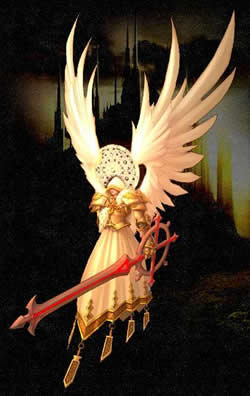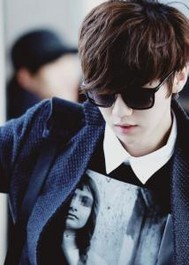the expression of emotion in man and animals-第38部分
按键盘上方向键 ← 或 → 可快速上下翻页,按键盘上的 Enter 键可回到本书目录页,按键盘上方向键 ↑ 可回到本页顶部!
————未阅读完?加入书签已便下次继续阅读!
powerfully affected by music; seems to bear the same relation to the above trembling of the body; as a slight suffusion of tears from the power of music does to weeping from any strong and real emotion。
_Devotion_。As devotion is; in some degree; related to affection; though mainly consisting of reverence; often combined with fear; the expression of this state of mind may here be briefly noticed。 With some sects; both past and present; religion and love have been strangely combined; and it has even been maintained; lamentable as the fact may be; that the holy kiss of love differs but little from that which a man bestows on a woman; or a woman on a man。'25' Devotion is chiefly expressed by the face being directed towards the heavens; with the eyeballs upturned。 Sir C。 Bell remarks that; at the approach of sleep; or of a fainting…fit; or of death; the pupils are drawn upwards and inwards; and he believes that 〃when we are wrapt in devotional feelings; and outward impressions are unheeded; the eyes are raised by an action neither taught nor acquired。〃 and that this is due to the same cause as in the above cases。'26' That the eyes are upturned during sleep is; as I hear from Professor Donders; certain。 With babies; whilst sucking their mother's breast; this movement of the eyeballs often gives to them an absurd appearance of ecstatic delight; and here it may be clearly perceived that a struggle is going on against the position naturally assumed during sleep。 But Sir C。 Bell's explanation of the fact; which rests on the assumption that certain muscles are more under the control of the will than others is; as I hear from Professor Donders; incorrect。 As the eyes are often turned up in prayer; without the mind being so much absorbed in thought as to approach to the unconsciousness of sleep; the movement is probably a conventional one the result of the common belief that Heaven; the source of Divine power to which we pray; is seated above us。
'24' ‘The Descent of Man;' vol。 ii。 p。 336。
A humble kneeling posture; with the hands upturned and palms joined; appears to us; from long habit; a gesture so appropriate to devotion; that it might be thought to be innate; but I have not met with any evidence to this effect with the various extra…European races of mankind。 During the classical period of Roman history it does not appear; as I hear from an excellent classic; that the hands were thus joined during prayer。 Mr。 Rensleigh Wedgwood has apparently given'27' the true explanation; though this implies that the attitude is one of slavish subjection。 〃When the suppliant kneels and holds up his hands with the palms joined; he represents a captive who proves the completeness of his submission by offering up his hands to be bound by the victor。 It is the pictorial representation of the Latin _dare manus_; to signify submission。〃 Hence it is not probable that either the uplifting of the eyes or the joining of the open hands; under the influence of devotional feelings; are innate or truly expressive actions; and this could hardly have been expected; for it is very doubtful whether feelings; such as we should now rank as devotional; affected the hearts of men; whilst they remained during past ages in an uncivilized condition。
'25' Dr。 Mandsley has a discussion to this effect in his ‘Body and Mind;' 1870; p。 85。
'26' ‘The Anatomy of Expression;' p。 103; and ‘Philosophical Transactions;' 1823; p。 182。
'27' ‘The Origin of Language;' 1866; p。 146。 Mr。 Tylor (‘Early History of Mankind;' 2nd edit。 1870; p。 48) gives a more complex origin to the position of the hands during prayer。 CHAPTER IX。
REFLECTIONMEDITATION…ILL…TEMPERSULKINESSDETERMINATION。
The act of frowningReflection with an effort; or with the perception of something difficult or disagreeable Abstracted meditationIll…temperMorosenessObstinacy Sulkiness and poutingDecision or determinationThe firm closure of the mouth。
THE corrugators; by their contraction; lower the eyebrows and bring them together; producing vertical furrows on the foreheadthat is; a frown。 Sir C。 Bell; who erroneously thought that the corrugator was peculiar to man; ranks it as 〃the most remarkable muscle of the human face。 It knits the eyebrows with an energetic effort; which unaccountably; but irresistibly; conveys the idea of mind。〃 Or; as he elsewhere says; 〃when the eyebrows are knit; energy of mind is apparent; and there is the mingling of thought and emotion with the savage and brutal rage of the mere animal。〃'1' There is much truth in these remarks; but hardly the whole truth。 Dr。 Duchenne has called the corrugator the muscle of reflection;'2' but this name; without some limitation; cannot be considered as quite correct。
'1' ‘Anatomy of Expression;' pp。 137; 139。 It is not surprising that the corrugators should have become much more developed in man than in the anthropoid apes; for they are brought into incessant action by him under various circumstances; and will have been strengthened and modified by the inherited effects of use。 We have seen how important a part they play; together with the orbiculares; in protecting the eyes from being too much gorged with blood during violent expiratory movements。 When the eyes are closed as quickly and as forcibly as possible; to save them from being injured by a blow; the corrugators contract。 With savages or other men whose heads are uncovered; the eyebrows are continually lowered and contracted to serve as a shade against a too strong light; and this is effected partly by the corrugators。 This movement would have been more especially serviceable to man; as soon as his early progenitors held their heads erect。 Lastly; Prof。 Donders believes (‘Archives of Medicine;' ed。 by L。 Beale; 1870; vol。 v。 p。 34); that the corrugators are brought into action in causing the eyeball to advance in accommodation for proximity in vision。
A man may be absorbed in the deepest thought; and his brow will remain smooth until he encounters some obstacle in his train of reasoning; or is interrupted by some disturbance; and then a frown passes like a shadow over his brow。 A half…starved man may think intently how to obtain food; but he probably will not frown unless he encounters either in thought or action some difficulty; or finds the food when obtained nauseous。 I have noticed that almost everyone instantly frowns if he perceives a strange or bad taste in what he is eating。 I asked several persons; without explaining my object; to listen intently to a very gentle tapping sound; the nature and source of which they all perfectly knew; and not one frowned; but a man who joined us; and who could not conceive what we were all doing in profound silence; when asked to listen; frowned much; though not in an ill…temper; and said he could not in the least understand what we all wanted。 Dr。 Piderit'3' who has published remarks to the same effect; adds that stammerers generally frown in speaking; and that a man in doing even so trifling a thing as pulling on a boot; frowns if he finds it too tight。 Some persons are such habitual frowners; that the mere effort of speaking almost always causes their brows to contract。
'2' ‘Mecanisme de la Physionomie Humaine;' Album; Legende iii。
'3' ‘Mimik und Physiognomik;' s。 46。
Men of all races frown when they are in any way perplexed in thought; as I infer from the answers which I have received to my queries; but I framed them badly; confounding absorbed meditation with perplexed reflection。 Nevertheless; it is clear that the Australians; Malays; Hindoos; and Kafirs of South Africa frown; when they are puzzled。 Dobritzhoffer remarks that the Guaranies of South America on like occasions knit their brows。'4'
From these considerations; we may conclude that frowning is not the expression of simple reflection; however profound; or of attention; however close; but of something difficult or displeasing encountered in a train of thought or in action。 Deep reflection can; however; seldom be long carried on without some difficulty; so that it will generally be accompanied by a frown。 Hence it is that frowning commonly gives to the countenance; as Sir C。 Bell remarks; an aspect of intellectual energy。 But in order that this effect may be produced; the eyes must be clear and steady; or they may be cast downwards; as often occurs in deep thought。 The countenance must not be otherwise disturbed; as in the case of an ill…tempered or peevish man; or of one who shows the effects of prolonged suffering; with dulled eyes and drooping jaw; or who perceives a bad taste in his food; or who finds it difficult to perform some trifling act; such as threading a needle。 In these cases a frown may often be seen; but it will be accompanied by some other expression; which will entirely prevent the countenance having an appearance of intellectual energy or of profound thought。
'4' ‘History of the Abipones;' Eng。 translat。 vol。 ii。 p。 59; as quoted by Lubbock; ‘Origin of Civilisation;' 1870; p。 355。
We may now inquire how it is that a frown should express the perception of something difficult or disagreeable; either in thought or action。 In the same way as naturalists find it advisable to trace the embryological development of an organ in order fully to understand its structure; so with the movements of expression it is advisable to follow as nearly as possible the same plan。 The earliest and almost sole expression seen during the first days of infancy; and then often exhibited is that displayed during the act of screaming; and screaming is excited; both at first and for some time afterwards; by every distressing or displeasing sensation and emotion;by hunger; pain; anger; jealousy; fear; &c。 At such times the muscles round the eyes are strongly contracted; and this; as I believe; explains to a large extent the act of frowning during the remainder of our lives。 I repeatedly observed my own infants; from under the age of one week to that of two or three months; and found that when a screaming…fit came on gradually; the first sign was the contraction of the corrugators; which produced a slight frown; quickly followed by the contraction of the other muscles round the eyes。 When an infant is uncomfortable or unwell; little




